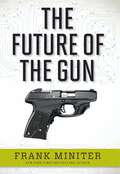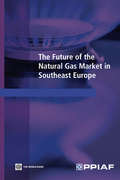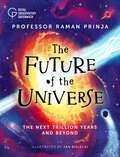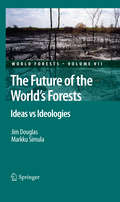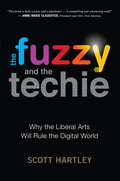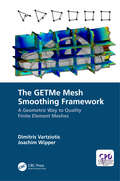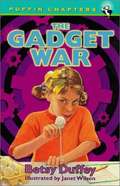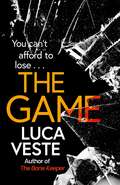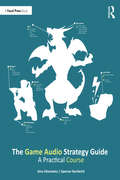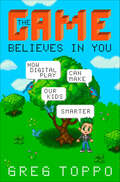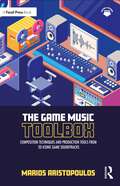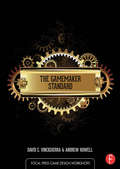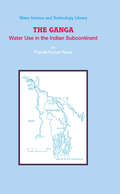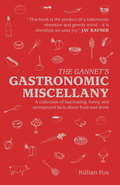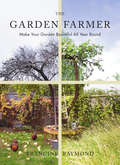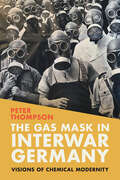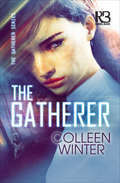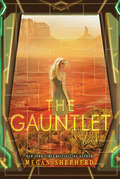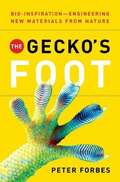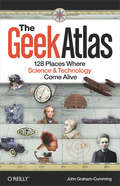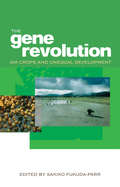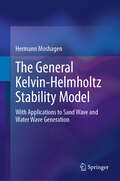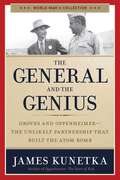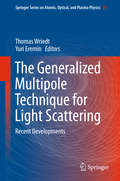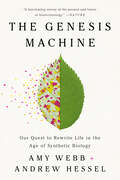- Table View
- List View
The Future of the Gun
by Frank MiniterThe history of the American gun is intricately entwined with the history of America itself. Promising developments in gun technology could change not only America's future, but the future of the world. Unfortunately, the radical anti-gun lobby is standing between innovation and the American people. Bestselling author Frank Miniter details the amazing breakthroughs waiting to happen in gun technology that could make today's firearms exponentially safer and smarter-if the anti-gun lobby weren't halting progress in its tracks.In The Future of the Gun, you will learn:Why anti-gun groups often oppose gun safetyfeatures How guns-and gun education for young people-cut crime How federalism could save your gun rights New trends in gun technology that will make guns safer and more effectiveWhy most talk about "assault rifles" is bogus How military and civilian gun technology have always advanced in tandem-for the benefit of soldiers and private citizens What guns could look like in just a few yearsWant to know about the future of guns? There is no better place to start than here.ter, more powerful handguns at prices (when adjusted for inflation) the world has never seen.Taurus, a Brazilian gun maker, played with using 3D printers to make guns over a decade ago. A Texas manufacturer has now made Model 1911 pistols out of steel with 3D printers ... the genie is out of the bottle.
The Future of the Natural Gas Market in Southeast Europe
by Franz GernerThis study was to analyze the future role of natural gas in the energy mix of countries of South East Europe. The study further identifies regional, cross-border and country-specific gas infrastructure projects that are economically, financially and technically sound. The study also analyses, and makes proposals for, the institutional and policy issues relating to funding and implementing gas infrastructure projects. The study examines sources of gas supply from Russia, the Caspian region and other current and prospective producer countries through Turkey and other transit routes (including LNG) and assesses costs of supply and gasification prospects in nine gas markets in the South East Europe region: * Albania * Bosnia and Herzegovina * Bulgaria * Croatia * Kosovo * Macedonia * Montenegro * Romania * Serbia These markets are all signatories of the Athens Memoranda of 2002 and 2003, which commit the participants to regional cooperation in electricity and gas.
The Future of the Universe
by Raman PrinjaExperience the explosive and colourful future of the cosmos, zooming trillions of years ahead in time with Professor Raman Prinja, published in association with Royal Observatory Greenwich.The Future of the Universe starts the future clock NOW and rockets readers along a forward time line to discover what scientists predict will happen to the universe, including a shiny new ring on Mars, Earth's axis flip and a dramatic galaxy crash!This is the first book of its kind for this age - putting all the future events into one place along a clear timeline, from the return of famous comets in a few decades, to the dark end of the Universe a nonillion years from now.Professor Raman Prinja is the international, multi-award-winning Head of Department for Physics and Astronomy at University College London and a celebrated children's author of many books, including Planetarium and Wonders of the Night Sky. Illustrator Jan Bielecki's action-packed, vivid artwork plucks these astonishing phenomena out of the distant future, and explodes them on the page - sizzling red giant stars and deep, mysterious dark energy; doomed moons and trailing comets - they're all inside The Future of the Universe!Professor Prinja pens this unique look at the Universe's future as his follow-up to the definitive and exciting Wonders of the Night Sky, which introduces anyone with a patch of sky and a curious mind to exploring the marvels on display in today's Universe. The next generation of Universe explorers can easily engage with astronomy through these stunning books, no expensive equipment needed.
The Future of the World's Forests: Ideas vs Ideologies
by Markku Simula Jim DouglasAt the landmark 1992 United Nations Conference on Environment and Development (Earth Summit), solemn resolutions were made both to protect the world's biodiversity and to co-operate on managing natural forests in a sustainable and ecologically responsible way. If anything, given recent developments in issues such as climate change and poverty, the problem of protecting and sustaining forests should logically have become more important globally. Yet public interest in, and development support for, forest activities have declined and rates of forest loss remain stubbornly high. Why has this happened? This book seeks answers to this question. It examines the often dysfunctional relationships between various members of the international forest constituency, which have so often prevented the formation of consensus. It also explores the tendency to pursue technical and politically convenient 'fixes' focused on the internal workings of the forest sector, while ignoring the overwhelming influence of external forces on the fate of forests. The result, all too often, has been programs which benefit a few powerful players and fail to provide real solutions. The book provides a new examination of and perspective on the international forest policy debate. It clarifies the reasons for global forest conflicts and provides insight for future policy development. Including examples from both the developed and developing world, it provides an invaluable resource for researchers and graduate students in forest policy and international relations, as well as a useful reference for policymakers and professionals in the forest sector, the development community and conservationists. With significant global attention now focused on reducing carbon emissions from deforestation and forest degradation (REDD), the authors examine the promise and the potential problems that apply to this initiative.
The Fuzzy and the Techie: Why the Liberal Arts Will Rule the Digital World
by Scott Hartley&“Artfully explains why it is time for us to get over the false division between the human and the technical.&”—Tim Brown, CEO of IDEO and author of Change by Design Scott Hartley first heard the terms fuzzy and techie while studying political science at Stanford University. If you majored in humanities or social sciences, you were a fuzzy. If you majored in computer or hard sciences, you were a techie. While Silicon Valley is generally considered a techie stronghold, the founders of companies like Airbnb, Pinterest, Slack, LinkedIn, PayPal, Stitch Fix, Reddit, and others are all fuzzies—in other words, people with backgrounds in the liberal arts. In this brilliantly counterintuitive book, Hartley shatters assumptions about business and education today: learning to code is not enough. The soft skills—curiosity, communication, and collaboration, along with an understanding of psychology and society&’s gravest problems—are central to why technology has value. Fuzzies are the instrumental stewards of robots, artificial intelligence, and machine learning. They offer a human touch that is of equal—if not greater—importance in our technology-led world than what most techies can provide. For anyone doubting whether a well-rounded liberal arts education is practical in today&’s world, Hartley&’s work will come as an inspiring revelation. Finalist for the 2016 Financial Times/McKinsey Bracken Bower Prize and A Financial Times Business Book of the Month
The GETMe Mesh Smoothing Framework: A Geometric Way to Quality Finite Element Meshes
by Joachim Wipper Dimitris VartziotisHigh quality meshes play a key role in many applications based on digital modeling and simulation. The finite element method is a paragon for such an approach and it is well known that quality meshes can significantly improve computational efficiency and solution accuracy of this method. Therefore, a lot of effort has been put in methods for improving mesh quality. These range from simple geometric approaches, like Laplacian smoothing, with a high computational efficiency but possible low resulting mesh quality, to global optimization-based methods, resulting in an excellent mesh quality at the cost of an increased computational and implementational complexity. <P><P>The geometric element transformation method (GETMe) aims to fill the gap between these two approaches. It is based on geometric mesh element transformations, which iteratively transform polygonal and polyhedral elements into their regular counterparts or into elements with a prescribed shape. GETMe combines a Laplacian smoothing-like computational efficiency with a global optimization-like effectiveness. The method is straightforward to implement and its variants can also be used to improve tangled and anisotropic meshes. <P><P>This book describes the mathematical theory of geometric element transformations as foundation for mesh smoothing. It gives a thorough introduction to GETMe-based mesh smoothing and its algorithms providing a framework to focus on effectively improving key mesh quality aspects. It addresses the improvement of planar, surface, volumetric, mixed, isotropic, and anisotropic meshes and addresses aspects of combining mesh smoothing with topological mesh modification. <P><P>The advantages of GETMe-based mesh smoothing are demonstrated by the example of various numerical tests. These include smoothing of real world meshes from engineering applications as well as smoothing of synthetic meshes for demonstrating key aspects of GETMe-based mesh improvement. Results are compared with those of other smoothing methods in terms of runtime behavior, mesh quality, and resulting finite element solution efficiency and accuracy. <P><P>Features: <li>Helps to improve finite element mesh quality by applying geometry-driven mesh smoothing approaches. <li>Supports the reader in understanding and implementing GETMe-based mesh smoothing. <li>Discusses aspects and properties of GETMe smoothing variants and thus provides guidance for choosing the appropriate mesh improvement algorithm. <li>Addresses smoothing of various mesh types: planar, surface, volumetric, isotropic, anisotropic, non-mixed, and mixed. <li>Provides and analyzes geometric element transformations for polygonal and polyhedral elements with regular and non-regular limits. <li>Includes a broad range of numerical examples and compares results with those of other smoothing methods.
The Gadget War
by Betsy DuffeyMEET THE GADGET WHIZ.. Kelly Sparks has forty-three inventions to her credit -- and she's only in third grade! Just name a problem, and in no time Kelly will come up with a gadget to solve it. But when Albert Einstein Jones walks into Kelly's class, he becomes Kelly's stickiest problem yet! Albert's been to Young Inventor's Camp, and he's determined to prove who the real gadget whiz is. This is sure to be a mastermind fight to the finish!
The Game
by Luca Veste'The plot is twisty, edgy and dynamic enough to keep us hanging on until the chilling denouement' DAILY MAILAn edge-of-your-seat thriller that merges the twists of a psychological-mystery with the investigative layers of a procedural . . .THEY KNOW WHAT YOU DID You receive a call, an email, a text – someone knows your secret and they want to ruin you.AND THEY&’RE OUT FOR BLOOD If you don&’t do what they say, they&’ll tell everyone what you&’ve been hiding. They will come after you, destroy you, and they aren&’t afraid to kill. IT&’S TIME TO PLAY THE GAMEReaders love Luca Veste's novels . . . 'One of my favourite novels of 2020' READER REVIEW 'Dark and difficult to put down, a must read' READER REVIEW 'Reminded me somewhat of Adrian McGinty&’s The Chain' READER REVIEW High-concept serial killer thriller with twists and heart. Stunning' STEVE CAVANAGH 'A fast-paced mystery about friendships, secrets and fears with a twist in the tail that fooled me completely' CHRIS EWAN &‘Properly Stephen King-style creepy&’ IAN RANKIN &‘Perfectly terrifying' AMANDA JENNINGS &‘A dark and brilliant thriller from a writer who just gets better and better&’ MARK BILLINGHAM &‘An entertainingly nasty piece of work' CHRISTOPHER BROOKMYRE
The Game Audio Strategy Guide: A Practical Course
by Gina Zdanowicz Spencer BambrickThe Game Audio Strategy Guide is a comprehensive text designed to turn both novices and experienced audio designers into technical game audio pros. Providing both a theoretical foundation and practical insights, The Game Audio Strategy Guide offers a thorough look at the tools and methods needed to create industry-quality music and sound design for games. The text is supported by an extensive companion website, featuring numerous practical tutorials and exercises, which allows the reader to gain hands-on experience creating and implementing audio assets for games. The Game Audio Strategy Guide is the essential manual for anyone interested in creating audio for games, inside or outside the classroom.
The Game Believes in You: How Digital Play Can Make Our Kids Smarter
by Greg ToppoWhat if schools, from the wealthiest suburban nursery school to the grittiest urban high school, thrummed with the sounds of deep immersion? More and more people believe that can happen - with the aid of video games. Greg Toppo's The Game Believes in You presents the story of a small group of visionaries who, for the past 40 years, have been pushing to get game controllers into the hands of learners. Among the game revolutionaries you'll meet in this book: *A game designer at the University of Southern California leading a team to design a video-game version of Thoreau's Walden Pond. *A young neuroscientist and game designer whose research on "Math Without Words" is revolutionizing how the subject is taught, especially to students with limited English abilities. *A Virginia Tech music instructor who is leading a group of high school-aged boys through the creation of an original opera staged totally in the online game Minecraft. Experts argue that games do truly "believe in you." They focus, inspire and reassure people in ways that many teachers can't. Games give people a chance to learn at their own pace, take risks, cultivate deeper understanding, fail and want to try again—right away—and ultimately, succeed in ways that too often elude them in school. This book is sure to excite and inspire educators and parents, as well as provoke some passionate debate.
The Game Music Toolbox: Composition Techniques and Production Tools from 20 Iconic Game Soundtracks
by Marios AristopoulosThe Game Music Toolbox provides readers with the tools, models, and techniques to create and expand a compositional toolbox, through a collection of 20 iconic case studies taken from different eras of game music. Discover many of the composition and production techniques behind popular music themes from games such as Cyberpunk 2077, Mario Kart 8, The Legend of Zelda, Street Fighter II, Diablo, Shadow of the Tomb Raider, The Last of Us, and many others. The Game Music Toolbox features: Exclusive interviews from industry experts Transcriptions and harmonic analyses 101 music theory introductions for beginners Career development ideas and strategies Copyright and business fundamentals An introduction to audio implementation for composers Practical takeaway tasks to equip readers with techniques for their own game music The Game Music Toolbox is crucial reading for game music composers and audio professionals of all backgrounds, as well as undergraduates looking to forge a career in the video game industry.
The GameMaker Standard (Focal Press Game Design Workshops)
by David Vinciguerra Andrew HowellThis book teaches students and entry-level novices how to create games using the GameMaker engine. Readers will quickly hone their design skills with tutorials that are written so that beginners can quickly start building games while also providing lessons on how designers can 'level up' and add advanced options to their games. Readers will also have access to a website containing all the assets and resources to create their games, including sprites and animations, walk-through video tutorials of each lesson and music composed by professional musicians. Also provided are rubrics for instructors to use when grading student work or for readers learning on their own to evaluate their own work.
The Ganga
by Pranab Kumar ParuaThe geo-hydro-morphometry of the river Ganges has a history of long and wide variations as the river is continuously fed by the high Himalayas hill ranges, the highest in the world. The river is categorized as an international one, passing through several independent countries. The major flow of the river used to flow through the branch river, Bhagirathi-Hooghly on the banks of which both city and port of Calcutta (now renamed Kolkata) are situated. However, due to massive tectonic and morphological changes, the flow through the branch river has gradually decreased resulting in enormous damages to the port and the city. After more than a century of investigations on the probable causes of deterioration and its remedies, a barrage across the river had been constructed near a place called Farakka in the Murshidabad district of West Bengal, India for diversion of a part of lean season flow (40,000 cu secs) from the parent river to the branch river for the resuscitation of the branch river and revitalization of the port of Calcutta. The turmoil started since the construction of barrage between 1965-1975 and the major neighbouring countries, India and Bangladesh, were locked in the dispute over sharing the water of the parent river. After several rounds of discussions at different levels between the two countries, short-term agreements were signed two times, one in 1977 and the other in 1985, and finally one long term Treaty was signed in 1996 between the two countries in an atmosphere of peaceful co-existence. Audience: The book will be of interest to researchers and scientists, professionals and policymakers in water resources management and environmental science, conservation policy and development research.
The Gannet's Gastronomic Miscellany
by Killian Fox The GannetA FINANCIAL TIMES BOOK OF THE YEAR 2017 'This is the first physical manifestation of a much-loved online magazine that is a monument to Fox's obsessions. One for the bedside table.' - FINANCIAL TIMES 'This book is the product of a ludicrously obsessive and greedy mind - it is therefore an utter joy.' - JAY RAYNER 'Your consummate culinary guide' - THE GUARDIAN 'A vital work from a keen mind full to brimming with wonderful thoughts and ideas.' - JEREMY LEE 'The most original, entertaining and downright fascinating book.' - DAVE BROOM 'Exercise caution before you buy this book. In fact, be careful about even flipping it open. You think Instagram is addictive? Ha. This book is as essential and educational as it is delightful and weird, and I need someone to come rescue me immediately because I cannot seem to put the damn thing down.' - JEFF GORDINIER, FOOD & DRINKS EDITOR, ESQUIRE MAGAZINE 'Going beyond the usual food fixations, the book is presented in a fresh, visually inventive style that will appeal to anyone with even a passing interest in food.' - DARINA ALLEN, IRISH EXAMINER gannetnoun1. a large seabird with mainly white plumage, which catches fish by plunging into the water.2. British informal, a greedy person.The Gannet's Gastronomic Miscellany goes beyond the usual food fixations. Presented in a fresh, visually inventive style, it will appeal to anyone with a passing interest in food - which, in this gastronomy-obsessed age, is pretty much all of us.In this compendious hotpot of a book you'll find a guide to creating a hit food profile on Instagram, a cross-section of a tiffin box, an explainer on craft beer, the origin story of Chicken Marengo, a list of millennia-old products that are still edible today (should you be brave enough to try Irish bog butter or Ancient Egyptian honey) and many more delightful nuggets of information.
The Gas Mask in Interwar Germany: Visions of Chemical Modernity (Science in History)
by Peter ThompsonExploring the history of the gas mask in Germany from 1915 to the eve of the Second World War, Peter Thompson traces how chemical weapons and protective technologies like the gas mask produced new relationships to danger, risk, management and mastery in the modern age of mass destruction. Recounting the apocalyptic visions of chemical death that circulated in interwar Germany, he argues that while everyday encounters with the gas mask tended to exacerbate fears, the gas mask also came to symbolize debates about the development of military and chemical technologies in the Weimar Republic and the Third Reich. He underscores how the gas mask was tied into the creation of an exclusionary national community under the Nazis and the altered perception of environmental danger in the second half of the twentieth century. As this innovative new history shows, chemical warfare and protection technologies came to represent poignant visions of the German future.
The Gatherer (The Gatherer Series #1)
by Colleen WinterOne woman&’s brilliant invention unleashes a high-tech plague against humanity in this explosive eco-science-fiction thriller. Storm Freeman gave the world a miracle. She designed The Gatherer to draw electromagnetic energy from the air and disperse free and infinite electricity to rural and underprivileged communities. Her invention helped people but devalued power industries. Some revered Storm as a deity. Others saw her as an eco-terrorist. Then the miracle became a curse. The Gatherer unleashed a plague that damaged the human electrical system, bringing pain, suffering—and eventual death—to anyone continually exposed to the technology. Stricken herself, Storm goes into exile, desperate to find a cure—and destroy her invention. But there are people in the government and in the corporation that funded The Gatherer who refuse to publicly acknowledge the connection between the device and the spreading plague. And they will stop at nothing to find Storm and use her genius for military applications . . .
The Gauntlet
by Megan ShepherdPerfect for fans of Scott Westerfeld and The Maze Runner, The Gauntlet is the gripping finale to the thrilling and addictive Cage series about teens abducted from Earth by an otherworldly race—from Megan Shepherd, the New York Times bestselling author of the Madman’s Daughter series. Cora and her friends have escaped the Kindred station and landed at Armstrong—a supposed safe haven on a small moon—where they plan to regroup and figure out how to win the Gauntlet, the challenging competition to prove humanity’s intelligence and set them free. But Armstrong is no paradise; ruled by a power-hungry sheriff, it’s a violent world where the teens are enslaved and put to work in mines. As Nok’s due date grows closer, and Mali and Leon journey across space to rescue Cassian, the former inhabitants of the cage are up against impossible odds.With the whole universe at stake, Cora will do whatever it takes, including pushing her body and mind to the breaking point, to escape Armstrong and run the Gauntlet. But it isn’t just a deranged sheriff she has to overcome: the other intelligent species—the Axion, Kindred, Gatherers, and Mosca—all have their own reasons to stop her. Not knowing who to trust, Cora must rely on her own instincts to win the competition, which could change the world—though it might destroy her in the process.
The Gecko's Foot: Bio-inspiration, Engineering New Materials from Nature
by Peter ForbesArising from a series of articles he wrote for The Guardian aimed at a serious-minded general audience, this book explores topics of materials science and nanotechnology, and new understandings of nature. Forbes is inspired by the subject and he draws together a significant amount of technical and scientific information.
The Geek Atlas: 128 Places Where Science and Technology Come Alive
by John Graham-CummingThe history of science is all around us, if you know where to look. With this unique traveler's guide, you'll learn about 128 destinations around the world where discoveries in science, mathematics, or technology occurred or is happening now. Travel to Munich to see the world's largest science museum, watch Foucault's pendulum swinging in Paris, ponder a descendant of Newton's apple tree at Trinity College, Cambridge, and more.Each site in The Geek Atlas focuses on discoveries or inventions, and includes information about the people and the science behind them. Full of interesting photos and illustrations, the book is organized geographically by country (by state within the U.S.), complete with latitudes and longitudes for GPS devices. Destinations include:Bletchley Park in the UK, where the Enigma code was brokenThe Alan Turing Memorial in Manchester, EnglandThe Horn Antenna in New Jersey, where the Big Bang theory was confirmedThe National Cryptologic Museum in Fort Meade, MarylandThe Trinity Test Site in New Mexico, where the first atomic bomb was explodedThe Joint Genome Institute in Walnut Creek, CaliforniaYou won't find tedious, third-rate museums, or a tacky plaque stuck to a wall stating that "Professor X slept here." Every site in this book has real scientific, mathematical, or technological interest -- places guaranteed to make every geek's heart pound a little faster. Plan a trip with The Geek Atlas and make your own discoveries along the way.
The Gene Revolution: GM Crops and Unequal Development
by Sakiko Fukuda-ParrWhether or not to embrace GM technologies is a fundamental and politically charged question facing humanity in the 21st century, particularly in light of rapidly growing populations and the unknown future impacts of climate change. The Gene Revolution is the first book to bridge the gap between the ?naysayers? and ?cheerleaders? and look at the issues and complexities facing developing and transitional countries over decisions about GM in light of the reality of what is happening on the ground. The first part of the volume looks at the rise of GM crops, commercialization and spread of the technology and the different positions of the USA and the European Union on the GM question and the effect of global markets. The second part consists of country perspectives from Argentina, Brazil, China, India and South Africa, which provide insight into the profound challenges these countries face and the hard choices that have to be made. The final part takes the analysis a step further by comparing developing and transitional country experiences, and charts a future course for government policy on GM that supports growth, sustainability and equity for the many billions of people affected worldwide.
The General Kelvin-Helmholtz Stability Model: With Applications to Sand Wave and Water Wave Generation
by Hermann MoshagenThis book presents a generalized version of the classical Kelvin-Helmholtz instability, a useful tool which allows for new approaches when studying stability problems in fluid mechanics, as well as its important applications. It begins by providing an introduction to hydrodynamic stability and the Kelvin-Helmholtz (KH) instability. The author then develops the general KH stability model for a multi-layer flow system, which includes the conventional KH instability as a special case. This book also includes the detailed discussion of two important applications of this model: the generation of sand waves in alluvial channels and the generation of wind waves on water. Additionally, the effects of nonlinearities and the use of computational methods to study KH instability are included. This book serves as a concise and modern treatment of the KH stability model with specific attention paid to hydrodynamic stability analysis. It is ideal for graduate students interested in fluid dynamics as well as scientists and engineers in the fields of oceanography, geophysics, offshore engineering, and more.
The General and the Genius: Groves and Oppenheimer ? The Unlikely Partnership that Built the Atom Bomb
by James KunetkaTwo ambitious men. One historic mission. With a blinding flash in the New Mexico desert in the summer of 1945, the world was changed forever. The bomb that ushered in the atomic age was the product of one of history's most improbable partnerships. The General and the Genius reveals how two extraordinary men pulled off the greatest scientific feat of the twentieth century. Leslie Richard Groves of the Army Corps of Engineers, who had made his name by building the Pentagon in record time and under budget, was made overlord of the impossibly vast scientific enterprise known as the Manhattan Project. His mission: to beat the Nazis to the atomic bomb. So he turned to the nation's preeminent theoretical physicist, J. Robert Oppenheimer--the chain-smoking, martini-quaffing son of wealthy Jewish immigrants, whose background was riddled with communist associations--Groves's opposite in nearly every respect. In their three-year collaboration, the iron-willed general and the visionary scientist led a brilliant team in a secret mountaintop lab and built the fearsome weapons that ended the war but introduced the human race to unimaginable new terrors. And at the heart of this most momentous work of World War II is the story of two extraordinary men--the general and the genius.
The Generalized Multipole Technique for Light Scattering: Recent Developments (Springer Series on Atomic, Optical, and Plasma Physics #99)
by Thomas Wriedt Yuri EreminThis book presents the Generalized Multipole Technique as a fast and powerful theoretical and computation tool to simulate light scattering by nonspherical particles. It also demonstrates the considerable potential of the method. In recent years, the concept has been applied in new fields, such as simulation of electron energy loss spectroscopy and has been used to extend other methods, like the null-field method, making it more widely applicable. The authors discuss particular implementations of the GMT methods, such as the Discrete Sources Method (DSM), Multiple Multipole Program (MMP), the Method of Auxiliary Sources (MAS), the Filamentary Current Method (FCM), the Method of Fictitious Sources (MFS) and the Null-Field Method with Discrete Sources (NFM-DS). The Generalized Multipole Technique is a surface-based method to find the solution of a boundary-value problem for a given differential equation by expanding the fields in terms of fundamental or other singular solutions of this equation. The amplitudes of these fundamental solutions are determined from the boundary condition at the particle surface. Electromagnetic and light scattering by particles or systems of particles has been the subject of intense research in various scientific and engineering fields, including astronomy, optics, meteorology, remote sensing, optical particle sizing and electromagnetics, which has led to the development of a large number of modelling methods based on the Generalized Multipole Technique for quantitative evaluation of electromagnetic scattering by particles of various shapes and compositions. The book describes these methods in detail.
The Genesis Machine: Our Quest to Rewrite Life in the Age of Synthetic Biology
by Amy Webb Andrew HesselNamed one of The New Yorker's BEST BOOKS OF 2022 SO FARThe next frontier in technology is inside our own bodies. Synthetic biology will revolutionize how we define family, how we identify disease and treat aging, where we make our homes, and how we nourish ourselves. This fast-growing field—which uses computers to modify or rewrite genetic code—has created revolutionary, groundbreaking solutions such as the mRNA COVID vaccines, IVF, and lab-grown hamburger that tastes like the real thing. It gives us options to deal with existential threats: climate change, food insecurity, and access to fuel. But there are significant risks. Who should decide how to engineer living organisms? Whether engineered organisms should be planted, farmed, and released into the wild? Should there be limits to human enhancements? What cyber-biological risks are looming? Could a future biological war, using engineered organisms, cause a mass extinction event? Amy Webb and Andrew Hessel&’s riveting examination of synthetic biology and the bioeconomy provide the background for thinking through the upcoming risks and moral dilemmas posed by redesigning life, as well as the vast opportunities waiting for us on the horizon.
